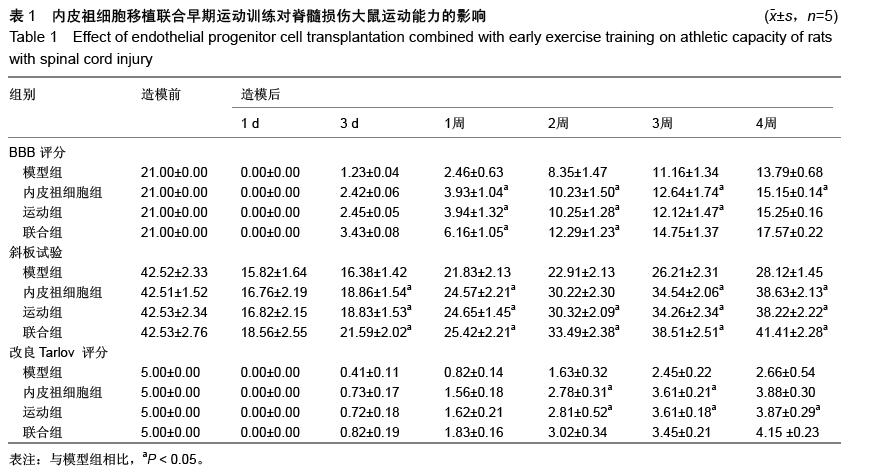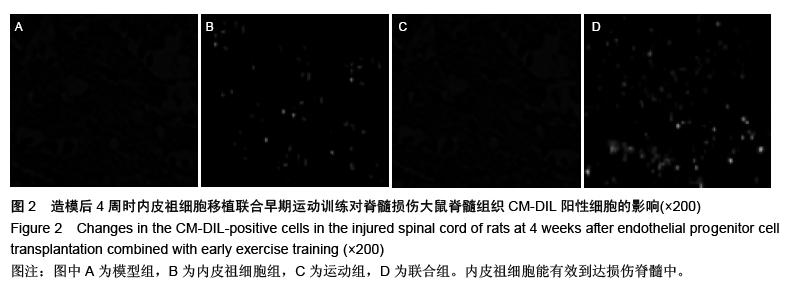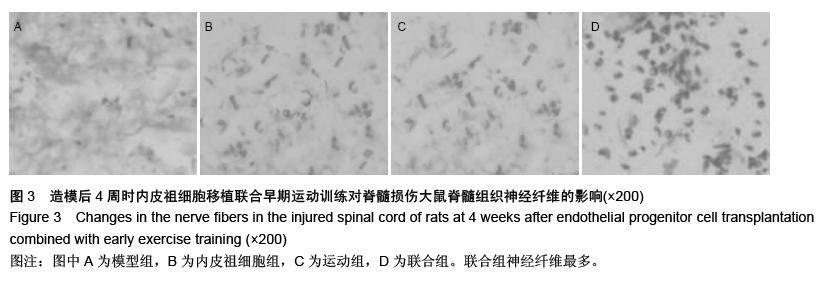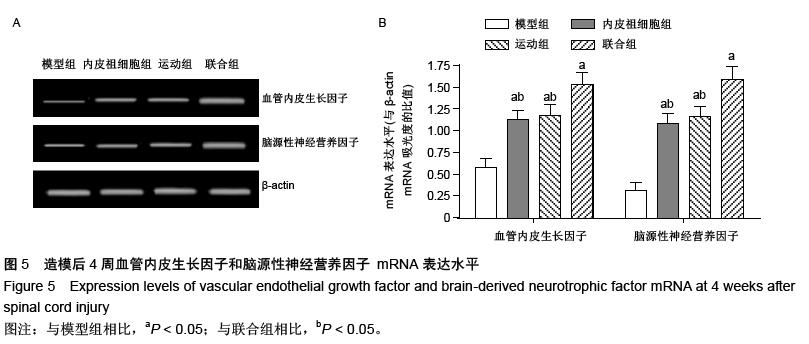| [1] 李建军,王方永.脊髓损伤神经学分类国际标准(2011年修订)[J].中国康复理论与实践,2011,17(10):963-970.
[2] Miyanji F, Furlan JC, Aarabi B, et al. Acute cervical traumatic spinal cord injury: MR imaging findings correlated with neurologic outcome--prospective study with 100 consecutive patients. Radiology. 2007;243(3): 820-827.
[3] Dzau VJ, Gnecchi M, Pachori AS, et al. Therapeutic potential of endothelial progenitor cells in cardiovascular diseases. Hypertension. 2005;46(1): 7-18.
[4] 赵学正,唐开.骨髓间充质干细胞治疗大鼠脊髓损伤移植途径的实验[J].中华骨与关节外科杂志,2015,(3):246- 252.
[5] Ghani U, Shuaib A, Salam A, et al. Endothelial progenitor cells during cerebrovascular disease. Stroke. 2005;36(1):151-153.
[6] Sakai H, Sheng H, Yates RB, et al. Isoflurane provides long-term protection against focal cerebral ischemia in the rat. Anesthesiology. 2007;106(1):92-99; discussion 8-10.
[7] 薛荣利,张媛媛,李泽慧,等.骨髓间充质干细胞在大鼠脊髓损伤治疗中的应用[J].解放军医药杂志,2015,27(10):4-7.
[8] Pluchino S, Cusimano M, Bacigaluppi M, et al. Remodelling the injured CNS through the establishment of atypical ectopic perivascular neural stem cell niches. Arch Ital Biol. 2010;148(2):173-183.
[9] Jin K, Xie L, Mao X, et al. Effect of human neural precursor cell transplantation on endogenous neurogenesis after focal cerebral ischemia in the rat. Brain Res. 2011;1374:56-62.
[10] Madhavan L, Collier TJ. A synergistic approach for neural repair: cell transplantation and induction of endogenous precursor cell activity. Neuropharmacology. 2010;58(6):835-844.
[11] 王革生,张庆俊,韩忠朝.人脐带间充质干细胞移植对大鼠脊髓损伤神经功能恢复的评价[J].中华神经外科杂志, 2006,22(1):18-21.
[12] 朱玉海,冯世庆,孔晓红,等.人脐带间充质干细胞与自体激活雪旺细胞联合移植修复脊髓损伤的实验研究[J].中华创伤骨科杂志.2009,11(8):747-751.
[13] Xiong Y, Mahmood A, Chopp M. Angiogenesis, neurogenesis and brain recovery of function following injury. Curr Opin Investig Drugs. 2010;11(3):298-308.
[14] 张海明,张映.神经生长因子对神经元作用的研究进展动物医学进展[J].动物医学进展,2006,27(9):39-41.
[15] Dosenko VE, Nagibin VS, Tumanovskaya LV, et al. Postconditioning prevents apoptotic necrotic and autophagic cardiomyocyte cell death in culture. Fiziol Zh. 2005;51(3):12-17.
[16] Papastefanaki F, Chen J, Lavdas AA, et al. Grafts of Schwann cells engineered to express PSA-NCAM promote functional recovery after spinal cord injury. Brain. 2007;130(Pt 8):2159-2174.
[17] Albin RL, Mink JW. Recent advances in Tourette syndrome research. Trends Neurosci. 2006;29(3): 175-182.
[18] Gulati R, Simari RD. Cell therapy for angiogenesis: embracing diversity. Circulation. 2005;112(11):1522- 1524.
[19] Traktuev DO, Prater DN, Merfeld-Clauss S, et al. Robust functional vascular network formation in vivo by cooperation of adipose progenitor and endothelial cells. Circ Res. 2009;104(12):1410-1420.
[20] 王亮,焦俊峰,王晓楠,等.脑损伤大鼠内皮祖细胞与早期血管新生的关系[J].中国神经精神疾病杂志,2010,36(3): 168-170.
[21] 石学银,邹最,徐振东,等.脊髓损伤大鼠动脉电生理的变化及丙泊酚的干预作用[J].临床麻醉学杂志,2006,22(5): 359-361.
[22] 尹述洲,秦洋,杨洁.丙泊酚对缺血再灌注损伤脊髓的保护作用[J].北方药学,2012,9(4):42-43.
[23] Yu QJ, Hu J, Yang J, et al. Protective effect of propofol preconditioning and postconditioning against ischemic spinal cord injury. Neural Regen Res. 2011;6(12): 951-955.
[24] 魏开斌,卓锋,刘红,等.移植脐带间充质干细胞治疗脊髓损伤的实验研究[J].中国矫形外科杂志,2012,20(22): 2081-2085.
[25] Wei HJ, Jiang RC, Liu L, et al. Circulating endothelial progenitor cells in traumatic brain injury: an emerging therapeutic target? Chin J Traumatol. 2010;13(5): 316-318.
[26] 薛荣利,张媛媛,李泽慧,等.骨髓间充质干细胞在大鼠脊髓损伤治疗中的应用[J].解放军医药杂志,2015,27(10):4-7.
[27] Kamei N, Kwon SM, Alev C, et al. Lnk deletion reinforces the function of bone marrow progenitors in promoting neovascularization and astrogliosis following spinal cord injury. Stem Cells. 2010;28(2): 365-375.
[28] 段大鹏,苏权,胡伟,等.同种异体骨髓间充质干细胞移植治疗大鼠脊髓损伤的时效性分析[J].中国骨伤,2013, 26(10): 845-849.
[29] Tanaka N, Kamei N, Nakamae T, et al. CD133+ cells from human umbilical cord blood reduce cortical damage and promote axonal growth in neonatal rat organ co-cultures exposed to hypoxia. Int J Dev Neurosci. 2010;28(7):581-587.
[30] 李葛威,吴成如,方健,等.富氢生理盐水对兔脊髓损伤神经细胞凋亡及凋亡相关蛋白表达的影响[J].颈腰痛杂志, 2015, (3):197-200.
[31] 张男,赵茗,孙亚澎.川芎嗪对大鼠脊髓损伤后运动功能恢复的影响及机制[J].中国医科大学学报,2015,44(1): 0-63.
[32] 张红,宋美香,孙向伟.神经干细胞移植结合注射用鼠神经生长因子治疗脊髓损伤的护理[J].中国保健营养(中旬刊), 2012,(12):208.
[33] Koda M, Okada S, Nakayama T, et al. Hematopoietic stem cell and marrow stromal cell for spinal cord injury in mice. Neuroreport. 2005;16(16):1763-1767.
[34] Xue S, Zhang HT, Zhang P, et al. Functional endothelial progenitor cells derived from adipose tissue show beneficial effect on cell therapy of traumatic brain injury. Neurosci Lett. 2010;473(3): 86-191.
[35] 李俊杰,饶耀剑,林斌,等.术后护理对Allen’s打击法制备SD大鼠SCI模型的影响[J].中外医学研究,2015,(31): 53-155.
[36] 宋启民,费昶,陈春美.运动诱发电位对兔腹主动脉阻断脊髓损伤的预警[J].中华实验外科杂志,2015,32(6):1386.
[37] Xiong Y, Mahmood A, Chopp M. Angiogenesis, neurogenesis and brain recovery of function following injury. Curr Opin Investig Drugs. 2010;11(3):298-308.
[38] Xiong Y, Mahmood A, Meng Y, et al. Neuroprotective and neurorestorative effects of thymosin β4 treatment following experimental traumatic brain injury. Ann N Y Acad Sci. 2012;1270:51-58.
[39] Thau-Zuchman O, Shohami E, Alexandrovich AG, et al. Combination of vascular endothelial and fibroblast growth factor 2 for induction of neurogenesis and angiogenesis after traumatic brain injury. J Mol Neurosci. 2012;47(1):166-172.
[40] Xiong Y, Mahmood A, Zhang Y, et al. Effects of posttraumatic carbamylated erythropoietin therapy on reducing lesion volume and hippocampal cell loss, enhancing angiogenesis and neurogenesis, and improving functional outcome in rats following traumatic brain injury. J Neurosurg. 2011;114(2): 549-559.
[41] Wels J, Kaplan RN, Rafii S, et al. Migratory neighbors and distant invaders: tumor-associated niche cells. Genes Dev. 2008;22(5):559-574.
[42] Mareel M, Madani I. Tumour-associated host cells participating at invasion and metastasis : targets for therapy? Acta Chir Belg. 2006;106(6):635-640.
[43] Kopfstein L, Christofori G. Metastasis: cell-autonomous mechanisms versus contributions by the tumor microenvironment. Cell Mol Life Sci. 2006;63(4): 449-468.
[44] Bidard FC, Pierga JY, Vincent-Salomon A, et al. A "class action" against the microenvironment: do cancer cells cooperate in metastasis? Cancer Metastasis Rev. 2008;27(1):5-10.
[45] Brown LF, Guidi AJ, Schnitt SJ, et al. Vascular stroma formation in carcinoma in situ, invasive carcinoma, and metastatic carcinoma of the breast. Clin Cancer Res. 1999;5(5):1041-1056.
[46] Man YG, Gardner WA. Focal degeneration of basal cells and the resultant auto-immunoreactions: a novel mechanism for prostate tumor progression and invasion. Med Hypotheses. 2008;70(2):387-408.
[47] 柳兰仙,方志红.康复护理干预对脑卒中后抑郁症患者神经与运动功能的影响[J].中国药物与临床,2012,12(4): 536-538.
[48] 郭卫春,李军,熊敏,等.基质细胞衍生因子-1/趋化因子受体4轴在促红细胞生成素动员骨髓间充质干细胞治疗脊髓损伤中的作用[J].中华实验外科杂志,2015,32(7): 1506-1509. |
.jpg)




.jpg)
.jpg)
